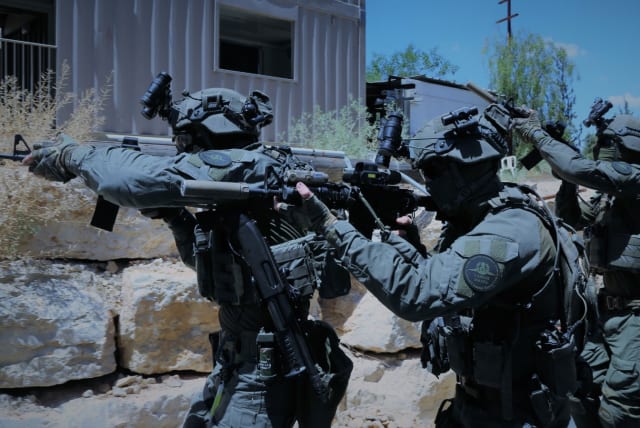Undercover in Gaza: Former undercover agent discusses infiltration operations

Peled said in these operations, forces must “blend in like a set of a movie, and be very quiet, and be very chill to get to our targets and drop off our costumes and become soldiers and fighters."
In an interview with the Wall Street Journal, published Wednesday, former Israeli counterterrorism officer Shir Peled discussed Israel’s undercover operations in Gaza and in the West Bank, notably Operation Arnon, resulting in the rescue of four hostages, and the undercover hospital raid in Jenin in January.
Peled is one of the first female officers to work with Yamas, a specialist unit within the Israeli Border Police.
“Our job as undercover fighters is to always come up with new tactical methods to fight in and to blend in the fields,” Peled said.
Undercover operations have been part of Israel’s arsenal for decades, however, these operational efforts expanded during the Second Intifada, when security forces worked to stop Palestinian terrorists from attacking Israelis in suicide bombings or stabbing attacks. This was when the undercover unit of the Border Police was established.
Mista‘arvim, is the name sometimes used for certain units in the IDF, Israel Border Police, and Israel Police that blend into local Arab populations to operate undercover while gathering intelligence or conducting law enforcement, hostage rescue, and counter-terrorism operations, according to the Wall Street Journal report.
Peled said that in these operations, forces must “blend in like a set of a movie, and be very quiet, and be very chill in order to get to our targets and drop off our costumes and become soldiers and fighters.” She also discussed how she had to get used to being out of control and “learn how to work in big uncertainty.”
Those in undercover units rely on intelligence gathered from Palestinian informants and Israeli undercover agents, and during operations, there are generally thousands of soldiers on standby just in case.
Hostage rescue operation
The two main undercover operations Peled discussed in the interview was the hostage rescue operation, titled Operation Arnon, in which Noa Argamani (25), Almog Meir (21), Andrey Kozlov (27) and Shlomi Ziv (40) were rescued from captivity, as well as the undercover operation in a Jenin hospital, which targeted a terror cell and thwarted a large terror attack that was being planned.
Israel declined to discuss the use of civilian vehicles during the hostage rescue operation, however eyewitnesses said that a commercial truck was used to transport agents into the area of the Nuseirat refugee camp, where the operation took place. Peled said that vehicles are like costumes. “It's not enough to find the right vehicle, but you need to disguise it so it will work in this specific territory.”
Many of the operations that Division 98 had been carrying out in central Gaza and Nuseirat since the middle of the previous week were part of an elaborate decoy to make the Hamas terrorists feel like the IDF was nearby but did not know where the hostages were while allowing security forces to set up a close-by rescue operation secretly.
Although the four hostages were rescued, there were many casualties, including dozens of civilians.
Jenin hospital undercover operation
In January, Israeli counterterrorism forces foiled an October 7-inspired terror attack, targeting a cell hiding and planning the attack from the Ibn Sina hospital in Jenin, the West Bank.
Hamas terrorist Mohammad Jalamna was killed during the operation, along with two fellow terrorists who hid alongside him at the hospital.
Jalamna, a resident of the Jenin refugee camp, was in direct communications with Hamas leadership abroad and was responsible for transferring weaponry and ammunition to Hamas terrorists across the West Bank for shooting attacks targeting Israelis.
The Israeli forces entered the hospital dressed as Arab doctors, patients, and nurses, as seen in CCTV footage shared on social media. Peled said in the interview that the accessories used in the undercover operation were essential to the disguise, such as a wheelchair one operative was carrying.
Peled said this operation was unusual because they do not usually go inside buildings unless necessary.
Other instances in which undercover agents posed as Palestinians include at demonstrations, mainly because there can be so much going on. Those there do not focus on what the undercover agents are doing, so the agents have more of an element of surprise. Peled added that the element of surprise is crucial.
Jerusalem Post Store
`; document.getElementById("linkPremium").innerHTML = cont; var divWithLink = document.getElementById("premium-link"); if (divWithLink !== null && divWithLink !== 'undefined') { divWithLink.style.border = "solid 1px #cb0f3e"; divWithLink.style.textAlign = "center"; divWithLink.style.marginBottom = "15px"; divWithLink.style.marginTop = "15px"; divWithLink.style.width = "100%"; divWithLink.style.backgroundColor = "#122952"; divWithLink.style.color = "#ffffff"; divWithLink.style.lineHeight = "1.5"; } } (function (v, i) { });

